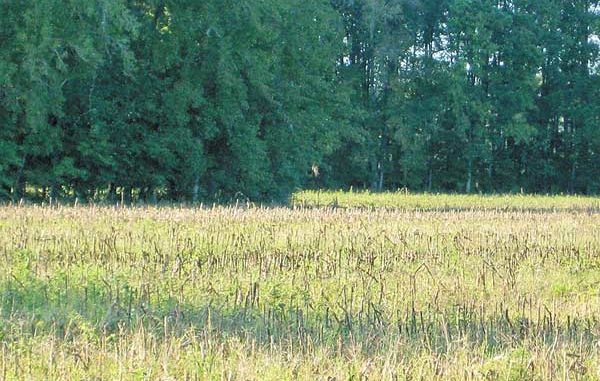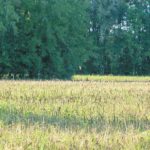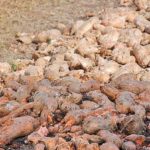
Deer hunting has its highs and lows, but there is nothing like sitting in a tree stand, peering through the predawn darkness, anxiously awaiting the gentle glow from the eastern sky. As daylight draws close, the eyes begin to construct shapes throughout the lush, over-sized food plot. There is no other place a well-seasoned hunter would like to be. In fact, a large and well-cultivated food plot carrying loads of mouth-watering, succulent forage for the deer herd to pillage is the perfect food source, deer attractant, and an ideal stand set-up.
However, anyone who has ever tried to grow food plots understands the investments needed to cultivate perfect food plots. Unfortunately, many hunters lack the logistical resources or don’t have areas available to construct food plots that become a staple, reliable food source for wildlife.
While food plots are preferred, other alternatives are available to mimic the same conditions.
Economic Option: Super-Sized Plot
While many big bucks end up taking their last steps in these types of food plots, the majority of deer are killed throughout the Carolinas by hunters utilizing other methods, whether they’re food piles, natural food sources, trails, dog driving, or agricultural fields. A food plot is nothing other than a well-cultivated agricultural crop.
According to the U.S. Department of Agriculture’s Economic Research Service, North and South Carolina collectively have more than 14 million acres of active farmland in 2004. Of course, a portion of these agricultural lands may have been planted with cotton, tobacco, centipede sod or other non-food sources.
The majority of agriculture consists of soybeans, peanuts, corn, and other food crops with high wildlife value. Agricultural fields are the “super-sized plot” and are prime areas to erect stands and to hunt over without having to expend any resources at all. Farmers spend thousands of dollars producing rich crops. Deer and hunters get to profit from the farmer’s successful crops. Even when crops are harvested, the waste remaining is generally sufficient to support wildlife several months afterwards, creating a massive food plot during deer season.
Does and bucks will utilize agricultural fields during all phases of the breeding season. Does will stay close to food banks as long as the food remains. Bucks will utilize food banks heavily early in the year, but they will scatter as their breeding hormones begin to flow and then will return after the majority of the breeding season is over. Even though many of the bucks scatter, the does attracted to agriculture fields will attract other bucks into the area.
Deer and other wildlife seek reliable food sources during the fall. Well-managed food plots or productive agricultural fields are both excellent locations to encounter a trophy buck. Whether food plots or agricultural fields become the site for a stand set-up, stay close to the best and most-reliable food source on the farm for the best results during deer season.
Healthy Alternatives
For many hunters of the Carolinas, baiting has become an essential component — where legal — to their deer hunting, and corn is the usually the choice. Deer love corn and can’t seem to get enough of it. There are few places where a bag of corn will last more than a few days. Cut corn fields, especially fields with sloppy harvests, are prime stand locations. Deer will plow into these fields and gobble up every last kernel. Deer living within the agriculture belt and the heavy-baiting regions will increase their body mass by nearly 10 percent during the fall.
The United States produces more than 300 million metric tons of corn per year. While most of the national crop is used for domestic products, many farmers within areas where baiting is legal and heavily practiced grow hundreds, if not thousands of acres of corn just to shove in white sacks and be hauled into the deer woods. While feeding corn is a surefire method to get a routine visitation from the herd, its overall nutritional value is poor and provides nothing but empty energy for the animals.
Corn is comprised of mostly carbohydrates, packed with energy but with low levels of protein, usually five to seven percent. Protein is an essential component for all animals. Proteins contribute to every functional system in the body, and animals will instinctively crave high-protein foods. For a healthy herd, the majority of the animals’ energy intake must contain high levels of protein. As a whole, the deer herd must consume protein-rich foods, containing 15 to 20 percent crude protein. Protein is required for growth for all age classes and plays a crucial role in antler development, lactation, gestation, and overall maintenance.
Of course, food plots are the best solution, with the highest nutritional value and least cost, but everybody does not have access to a tractor or the permission to cultivate food plots on leased land. Fortunately for the hunters in the farming belt, other options are available with similar costs to replace heavy corn use for feeding the deer.
Soybeans: ‘The Protein Bomb’
Other grains or agriculture crops are available, such as soybeans. They are abundant within the Carolinas. On average, North Carolina produces more soybeans than any other row crop, making up 1.7 percent of the national production in 2003. North Carolina alone produces between one and two million acres of soybeans annually, and South Carolina produces between 500 to 700 thousand acres annually.
Just like corn, soybeans have thousands of domestic uses. They are packed with protein, and depending on the variety, contain up to 45 percent crude protein. Soybeans are a little more expensive and require additional legwork to purchase, but they are very nutritional for the deer herd. Deer love them, and soybeans are a good substitute for corn when feeding deer. The firm skins and roundish shape makes soybeans ideal for feeders as well.
Sweet Potatoes: The ‘Super Food’
Sweet potatoes are a perfect deer food. Labeled as a “super food” by health experts, they come packed with essential vitamins, minerals, and loads of carbohydrates.
Although low in protein (one to seven percent), sweet potatoes’ other nutritional contents are perfect food supplements and attractants for deer. Do not expect deer to jump right on a sweet potato pile and dig in. There appears to be a learning curve, or maybe an aging process, before the deer begin to ravage them.
In areas void of sweet potatoes, deer will not start eating until the potatoes begin to over-ripen. As a sweet potato ripens, the starches covert to simple sugars and develop a sweet aroma and taste. After deer finally get a taste, they will gobble them up and will be looking for more.
However, inexpensive access to cull or surplus sweet potatoes is generally only available to hunters within the coastal planes of North Carolina and South Carolina, the regions where most are grown. Several buying/sorting/processing facilities are located east of the I-95 corridor in central North Carolina, as well as along the state line in Columbus County.
Surplus or cull sweet potatoes can be purchased by the crate for $10 to 20 per load. Crates are emptied into a truck bed or attached trailer to be transported back to the hunting area. Handling large loads of sweet potatoes can be troublesome, and several trips to the supplier are usually required. However, the same money invested in several loads of sweet potatoes versus corn will provide a longer lasting, more nutritional food source for the deer. While a little more difficult to handle and transport, sweet potatoes are great alternatives to lesser nutritional foods.






Be the first to comment